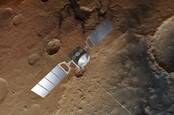This article is more than 1 year old
Out on a tangent: Almost two decades into its 5-year mission, INTEGRAL still delivers the gamma ray goods
From gravitational discoveries to controlled 2029 re-entry, they sure knew how to build 'em
All good things
Kuulkers accepted that the instruments may degrade over time, although highlighted techniques, such as the annealing used to remove contamination from the spectrometer, that have kept things operating and useful. He added: "We can still do the science we did in the beginning," which is no mean feat as the 20th anniversary nears.
He also paid tribute to ESA's Mission Operations Centre, explaining that the engineers have continued to find ways to eke out the spacecraft's resources and mitigate the gradual decline in power availability. The rate at which the spacecraft consumed fuel had been a concern, but "they found ways over time to slow down the usage, which is amazing."
Indeed, with the current rate of fuel consumption, INTEGRAL could remain operating right up until it re-enters the Earth's atmosphere in 2029.
"I think the only implication for science may be in a couple of years, when the power really drops," he added.
At present, the solar arrays of INTEGRAL can be pointed slightly away from the Sun to permit the visibility of a large slice of sky of up to 40 degrees (slightly less during eclipse seasons).
"If the power budget becomes critical," Southworth said, "then we might have to start to restrict the solar array aspect to the Sun. So first of all to 35 degrees and 30 degrees. So this reduces the sky visibility."

16 years and counting: How ESA squeezed oodles of bonus science out of plucky Mars Express probe
READ MOREPower aside, the rest of the spacecraft is ticking along nicely. The spacecraft uses a star tracker, Sun sensors and three reaction wheels for attitude control. Where other missions have had a few problems with ageing reaction wheels, INTEGRAL's have remained healthy.
Southworth suggested that this might be down to how INTEGRAL does its pointing. Where its sister observatory, XMM-Newton, tends to observe one target for as long as 36 hours while maintaining a stable attitude, INTEGRAL's pointings are considerably shorter or create a "dither" pattern around a target.
One theory is that keeping the wheels turning at one speed for long periods can be quite damaging, hence the longevity and health of the units of INTEGRAL.
The relative health has also meant that engineers have been able to tweak how the wheels are used. "We allow the wheels in the stable pointing to drift through the zero speed region," Southworth said, "which most of the missions don't, because one: they're worried about the pointing stability. And two: they're worried about degradation to the wheels at this speed."
Without such worries, engineers have been able to cut the fuel consumption, which is handy, because the ESA team has plans for it.
Whatever happens, the mission will not continue past 2029. The team burnt through a substantial quantity of fuel in 2015 adjusting the orbit, having been tasked in 2012 with how the four-tonne satellite might be disposed of. ESA is a little sensitive about space debris and engineers saw the potential for a dual opportunity.
This was: science until 2029 (assuming the fuel holds out) and then go for a controlled re-entry into the Earth's atmosphere with all the telemetry running.
We like to think of the spacecraft controllers in Darmstadt grappling with a joystick and yelling "Yahoo!" but we fear that things will be a little more sober.
Southworth told us he thought this would be the first such re-entry undertaken by ESA and described it as "another branch of engineering science" to be delivered by the veteran satellite.
Even if there should be a failure between now and then, and the veteran spacecraft tripped into Emergency Safe Attitude Mode (ESAM) during thruster firing for a reaction wheel dump as recently as 16 May (science operations resumed on 12 June), INTEGRAL will definitely be coming down in 2029 regardless.
Engineers have targeted the South Atlantic or Antarctica for disposal. If, as planned, INTEGRAL remains under control, controllers will drop the perigee in late 2028 or early 2029 to make the final decay a fast one and ensure the spacecraft re-enters as a whole.
"It will be the first time we'll be able to witness a live re-entry while taking telemetry," said Southworth. A final bit of bonus science from the mission.
I'd like to thank
Both Kuulkers and Southworth were effusive in their praise of the designers and manufacturers of the INTEGRAL spacecraft and instruments.
"That we can operate it after 18 years with relatively few problems... I think it's fantastic," said Southworth. "They did an excellent job, and as well as the design, I think also the testing on ground, pre-launch was tremendous."
Southworth did have some tips for future missions since these spacecraft do seem to live beyond all reasonable expectations. INTEGRAL was only designed to last five years: "Maybe it would have been good if somebody back in 2002 had said, 'OK, let's see how the how the orbit evolves not just over the next five years, but over the next 15 years... just in case,'" he laughed.
"And then we may have taken slightly different decisions about orbit maintenance but also at least we would have been forewarned and prepared."
He also had advice that rings true in fields away from INTEGRAL: "Preparation. Really prepare yourself. Think about everything that could go wrong."
The final part in this series will focus on the Solar and Heliospheric Observatory (SOHO), the ESA and NASA collaboration that was launched in 1996 and almost lost two years later. Oops. ®
